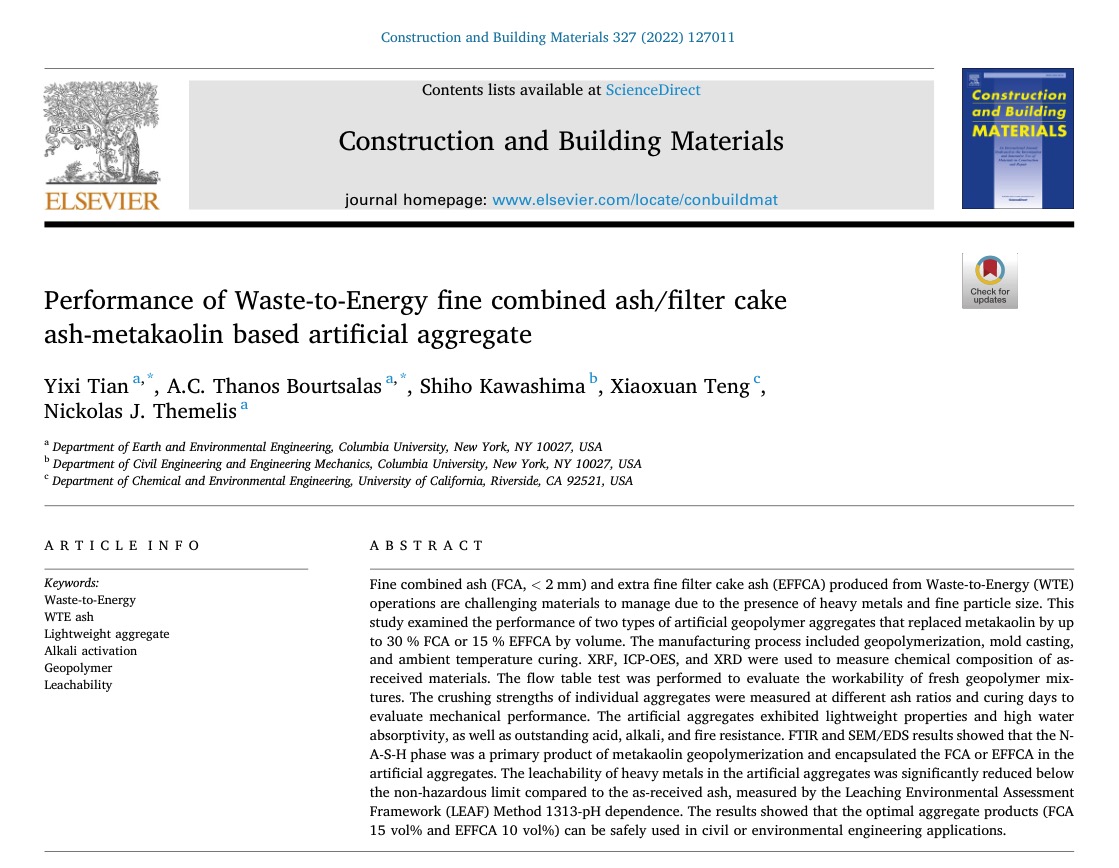Performance of Waste-to-Energy fine combined ash/filter cake ash-metakaolin based artificial aggregate
By Yixi Tian*, A.C. (Thanos) Bourtsalas*, Shiho Kawashima, Xiaoxuan Teng, Nickolas J. Themelis
Journal: Construction and Building Materials Volume 327 (11 April 2022), 127011
Department of Earth and Environmental Engineering
Fu Foundation School of Engineering & Applied Science
Columbia University
The study was supported by the Earth Engineering Center of Columbia University and Global WtERT Council, Inc. The authors gratefully acknowledge the contribution of the engineers of Covanta for the sample collection.
Highlights
- • Use WTE fine combined ash and filter cake ash to produce artificial aggregates.
- • Replace metakaolin by WTE ashes via geopolymerization, casting, and room curing.
- • Ash aggregates present good mechanical, lightweight, and resistant properties.
- • Heavy metals in WTE ashes are effectively stabilized by geopolymerized matrix.
- • Ash aggregates can be safely used in civil engineering applications.
Abstract
Fine combined ash (FCA, < 2 mm) and extra fine filter cake ash (EFFCA) produced from Waste-to-Energy (WTE) operations are challenging materials to manage due to the presence of heavy metals and fine particle size. This study examined the performance of two types of artificial geopolymer aggregates that replaced metakaolin by up to 30 % FCA or 15 % EFFCA by volume. The manufacturing process included geopolymerization, mold casting, and ambient temperature curing. XRF, ICP-OES, and XRD were used to measure chemical composition of as-received materials. The flow table test was performed to evaluate the workability of fresh geopolymer mixtures. The crushing strengths of individual aggregates were measured at different ash ratios and curing days to evaluate mechanical performance. The artificial aggregates exhibited lightweight properties and high water absorptivity, as well as outstanding acid, alkali, and fire resistance. FTIR and SEM/EDS results showed that the N-A-S-H phase was a primary product of metakaolin geopolymerization and encapsulated the FCA or EFFCA in the artificial aggregates. The leachability of heavy metals in the artificial aggregates was significantly reduced below the non-hazardous limit compared to the as-received ash, measured by the Leaching Environmental Assessment Framework (LEAF) Method 1313-pH dependence. The results showed that the optimal aggregate products (FCA 15 vol% and EFFCA 10 vol%) can be safely used in civil or environmental engineering applications.
Please cite the link to the journal: https://doi.org/10.1016/j.conbuildmat.2022.127011

